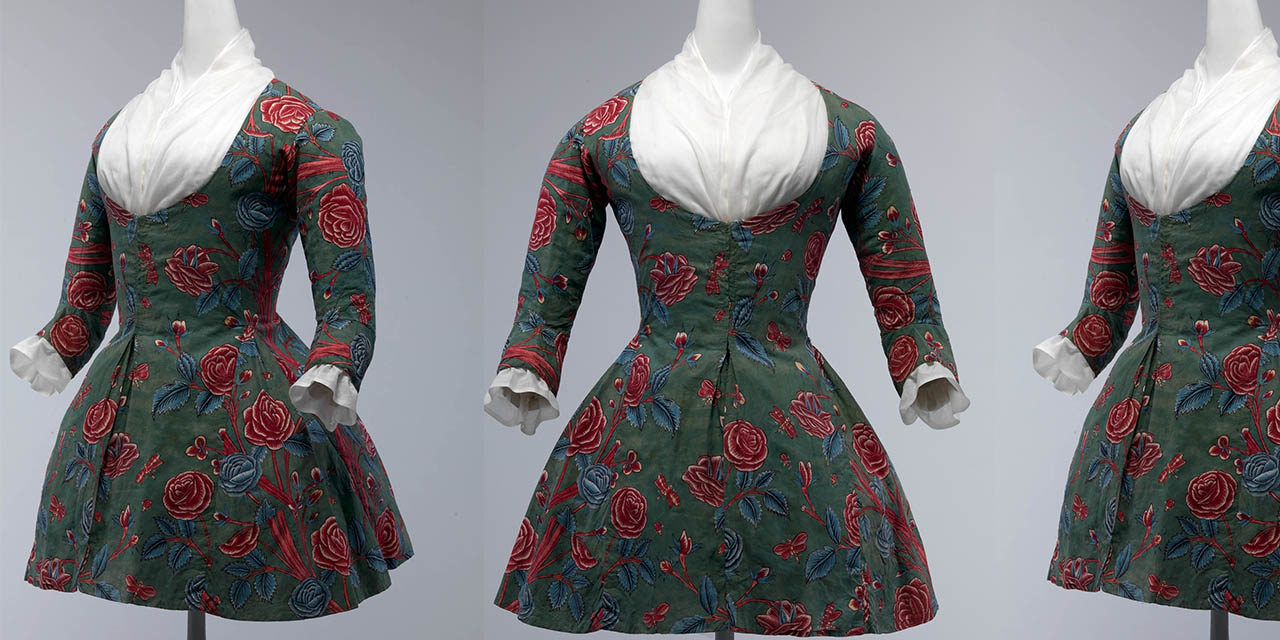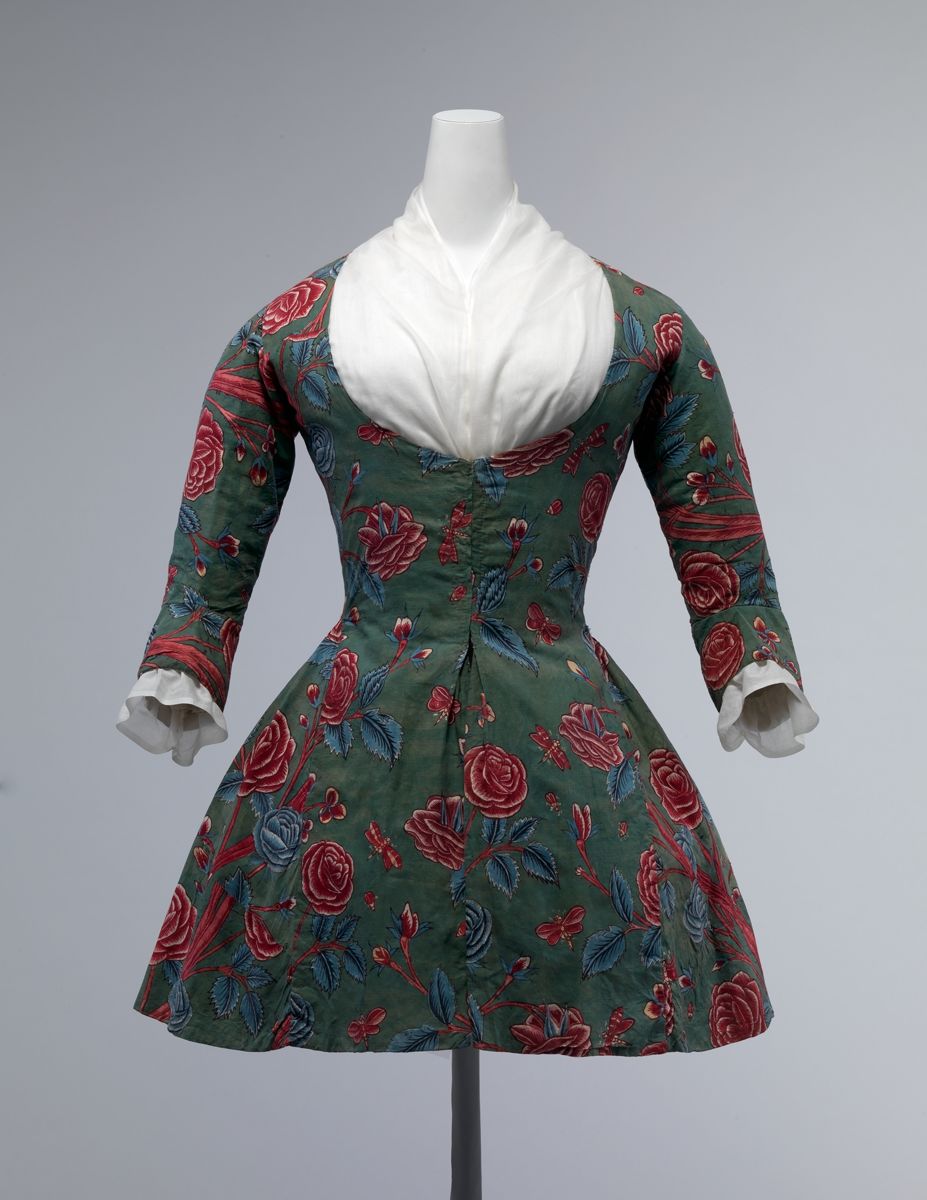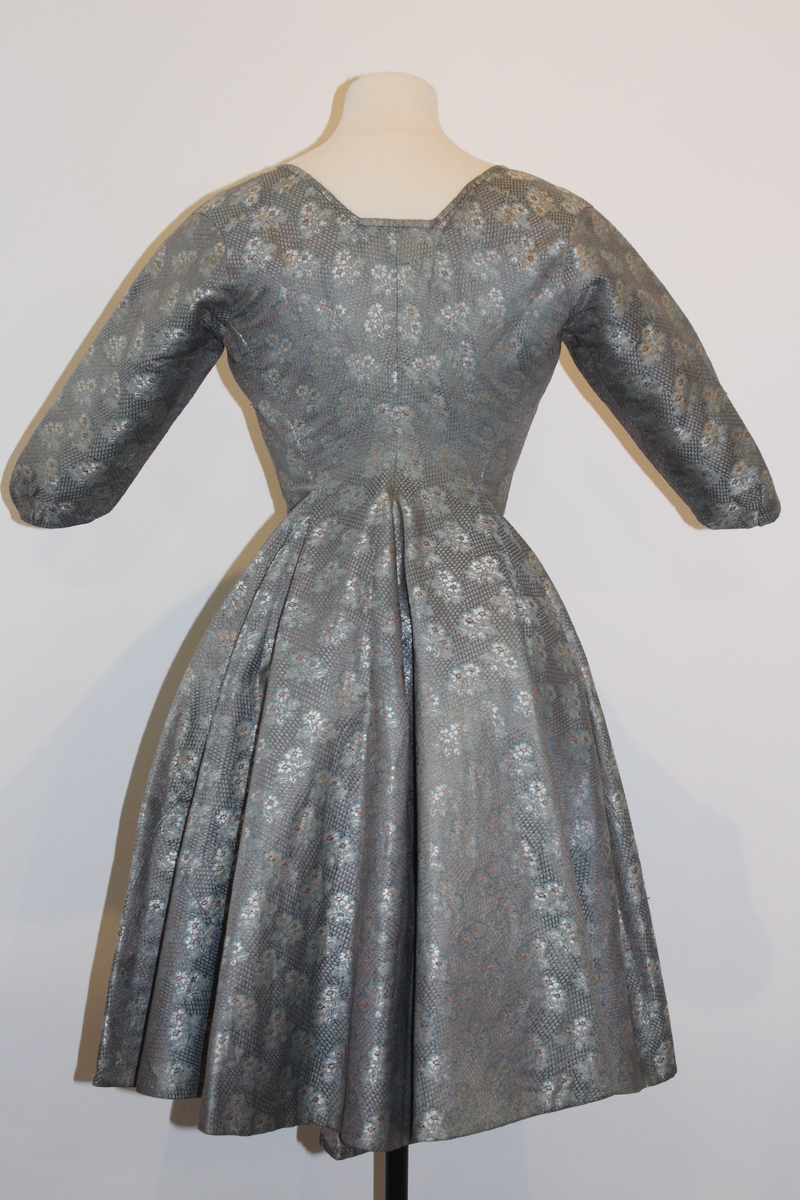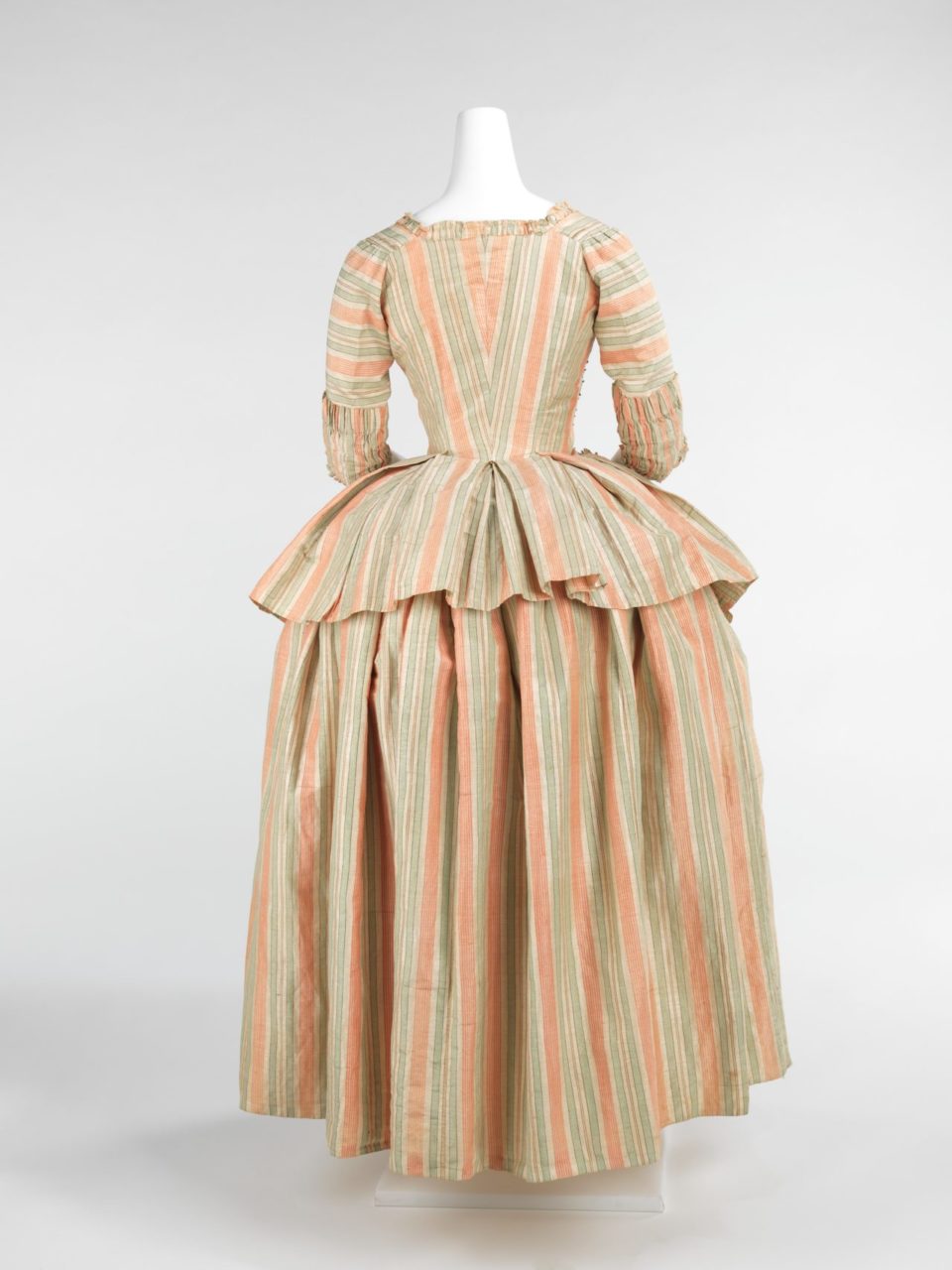18th century women’s jacket, fitted around the torso and flared out after the waist.
The Details
Phyllis Tortora and Keith Eubank, in their Survey of Historic Costume (2010), described the origins of the caraco:
“Fashionable two-piece garments included skirts worn with a long, fitted jacket (the caraçao (kara-sow) bodice) similar in style to the aforementioned casaquin in cut […] and jackets based on English men’s riding dress, worn with men’s hats.” (284)
Figure 1 shows a dark polychrome chintz caraco printed with roses from the second half of the 18th century. Note the stacked pleats at center front and at sides, creating the flare that the garment needs in order to sit properly on top of the large skirt. The neckline on this one is so low that it needs to be filled in with a fichu.
In 20,000 Years of Fashion: The History of Costume and Personal Adornment (1987), François Boucher described short garments and dresses:
“Throughout the century women wore short garments like the usual dresses, but cut off at hip-level; the truncated sack gown, or casa-keen, the shortened robe à la française or caraco, the abbreviated redingote or veste. However, the names are sometimes imprecise and some caracos are called pierrots, although it is not possible to seen any appreciable difference between them.” (307)
While caracos can vary in length and decoration, what differentiates them from other jacket-like garments is their fitted, non-pleated back (Fig. 2). The “shortened robe à la francaise” he discusses is often called a ‘short sack’ or a pet-en-l’air and has double box pleats billowing down from the neck and obscuring the curve of the back.
The fashion plate in figure 3 shows a young woman in a short pink silk caracot (the 18th-century French), with ruched silk trim and green color-blocking that matches her petticoat.
Fig. 1 - Designer unknown (Dutch). Caraco, second half 18th century. Cotton. New York: The Metropolitan Museum of Art, 2000.251. Purchase, Gifts from various donors, 2000. Source: MMA
Fig. 2 - Designer unknown. Caraco (back view), 1780-1790. Figured silk; centre back height 115cm. Manchester: Manchester City Galleries, 2003.171. Source: Manchester Art Gallery
Fig. 3 - Claude-Louis Desrais (French, 1746–1816). Gallerie des modes et costumes français: Demoiselle en caracot de taffetas, 1778. Hand-colored engraving on laid paper. Boston: Museum of Fine Arts, 44.1338. The Elizabeth Day McCormick Collection. Source: MFA
Fig. 4 - François Louis Joseph Watteau (French, 1758–1823). Gallerie des modes et costumes français: Jeune Danseuse vêtue d'un caracot Pierrot, 1787. Hand-colored engraving on laid paper; 29.5 x 21 cm (11 5/8 x 8 1/4 in). Boston: The Museum of Fine Arts, 44.1660. The Elizabeth Day McCormick Collection. Source: MFA
In her book The Fashion Dictionary (1973), Mary Brooks Picken defined the eighteenth-century caraco by its structural details:
“Gown with long basque finished with peplum ruffle; a train called a figaro, was attached under the peplum. Late 18th century.” (58)
‘Basque’ means that it extends beyond the waist, and caracos do not usually have waist seams. Not all caracos have peplums; the short ones that do are called pierrots (caracot à la pierrot or caracot pierrot, in fashion plates) (Fig. 4). To wit, all of the caracos featured here are indeed late 18th century; it is difficult to find one dating earlier.
The Metropolitan Museum of Art notes that caracos (here called ‘casaquins’) were used mainly for daywear:
“In the first half of the eighteenth century, ladies wore casaquins and petticoats for daywear as an alternative to the formal robe à la française. The casaquin, or jacket, was cut like a dress but came only to the hip. Usually the skirt was of a contrasting material or color and ended at the ankles. This popular costume was the basic ensemble for ladies of the bourgeoisie and for servants.”
While many caraco/petticoat ensembles matched (Fig. 5), less formal outfits could mix and match, like the blue pierrot caraco in figure 4 with its pink petticoat. The length of the caraco may have been at the whim of the wearer, or perhaps changed due to the formality of the occasion; the blue silk in figure 5 is much longer than the painted cotton in figure 6, and the caraco on the striped ensemble in figure 7 is the shortest of them all.
The terminology for women’s jackets in this era is complicated. In some cases, caraco is seen to refer to other kinds of jackets as a catch-all term, but generally it refers to fitted-back garments with shaped panels and the inverse box pleats at the waist. Casaquin is another word that might have been used to refer to a variety of jackets, as does ‘pierrot’ (though pierrots are generally the short, bodice-like kind). Some museums confuse the terms, so make sure to double-check if you see a label that looks odd.
Fig. 5 - Designer unknown (Dutch). Dress: jacket and skirt, 1780-1800. Blue silk damask, wool lining, and linen cuff lining. Antwerp: Mode Museum, OBJ34260 T12/1045AB/J137. Source: MoMu Open Fashion
Fig. 6 - Designer unknown (English (tailoring), Indian (textile)). Caraco and petticoat, 1770-1780. Cotton, painted and dyed. London: The Victoria & Albert Museum, T.229&A-1927. Given by Sir Luke Fildes KC. Source: VAM
Fig. 7 - Designer unknown (French). Dress (back view), ca. 1775. Silk. New York: The Metropolitan Museum of Art, 2009.300.917a, b. Gift of the Brooklyn Museum, 2009; H. Randolph Lever Fund, 1968. Source: MMA
References:
- Boucher, François. 20,000 Years of Fashion: The History of Costume and Personal Adornment. Expanded ed. New York: Harry N. Abrams, 1987. http://www.worldcat.org/oclc/777323433
- “Caraco.” The Metropolitan Museum of Art. Accessed December 16, 2018. https://www.metmuseum.org/art/collection/search/81534?searchField=All&sortBy=relevance&what=Caracos&ft=*&offset=0&rpp=20&pos=4
- Picken, Mary Brooks. The Fashion Dictionary: Fabric, Sewing, and Apparel as Expressed in the Language of Fashion. New York: Funk & Wagnalls, 1973. http://www.worldcat.org/oclc/911811835
- Tortora, Phyllis G., and Keith Eubank. Survey of Historic Costume: A History of Western Dress. New York: Fairchild Publications, 2010. http://www.worldcat.org/oclc/865480300

















